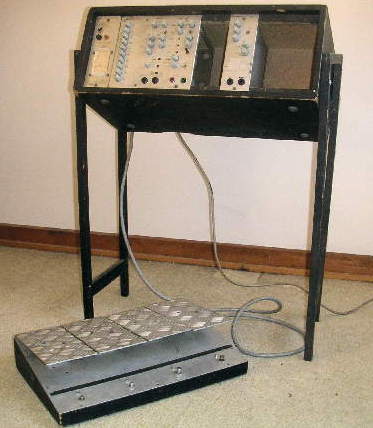The development history of the PARADIS guitar sound:
ALPHA 77 Modular Guitar Amp:
H. Hogg had taught me, that it is possible to get a nice distorted guitar sound with transistors and a linear amplifier system by boosting middle before and cutting treble after the distortion. I never had a guitar amplifier as any guitar player has. With the first money I earned soldering H. Hoggs huge mixing desks in '74, I bought effect modules from him, and built them into a handy amplifier with the following modules.
FET input stage. Later I used 072 and felt little difference.
10-Equalizer: All stages in series, each with discrete OP AMP and a double T filter. I mainly used it to boost a few bands between 400 and 2kHz to create round or aggressive distortions. Sometimes the single stages of the equalizer would bring the first distortion.
Distortion: Basically a overdriven 741. Hogg used a network with about 10 diodes to smoothen the clipping to imitate the tubes. But I hardly used it. With the right filtering, the straight clipping is nice as it produces less overtones than the transistor or diode curve. Asymmetry he also offered in various ways and I came to the conclusion that its unnecessary or even ugly because the natural harmonics of the string give it an asymmetry that becomes enhanced with the middle boost.
High Cut filter with variable frequency. Fundamental to make the sound warmer. At that time I used 12' cabinets, but never miked them. The High Cut allowed direct feeding of the desk at a sound quality that only became popular with the Red Box and similar products more than 10 years later.
Bucket Brigade Delay with Feedback, filtering and delay time control and complex modulations. It created all the sounds of the later Flanger, Chorus, Tremolo did, only that it was more difficult to operate and was noisy due to the immature first bucket brigade chips.

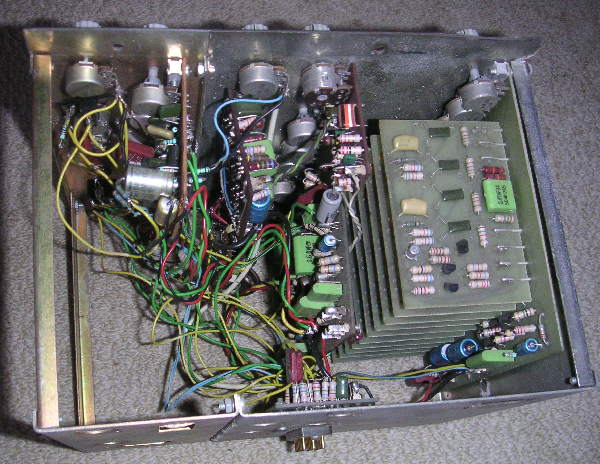
Needless to say that the whole construction was in constant change and as I improved my playing and found my picking styles, I rewired the amp and replaced more and more of Hoggs designs. The progressive rock band LIZARD was famous for these guitar sounds. I kept changing them a lot on stage and wished nothing more than to program them - impossible at that time due to noise, mainly.
The Compressor module was a LED-VCR combination as it was usual at the time to because VCAs were noisy. It is a limiter really, guitarists say compressor when they mean limiter. Setting the limit close to the clipping point of the distorting OPAmp, I get a very defined amount of distortion which makes the guitar sing smoothly and give the chords a hard attack with a warm crunch.
Then I started with the standard State Variable Filter, mixing all of its outputs. Through this, I found a very guitar appropriate form, simple to operate: A balance between the LP and BP output, with some HP fed to the tapper so that the middle position had the character of the BP, with strong bass and decently present treble.
In '85, when I changed my music, I abandoned the module system and built a completely new system that only contained the experience and the Hogg the 10-Equ, which I took out as well in '89 and started to use only my Guitar State Variable Filters filters in my setup. In the end I had three of them: one before the distortion, one rather fixed after and another one to modulate the sound by foot, like a very flexible WahWah that has a useful sound at each position and can become very crazy if the parameters are set extreme.
The schematic drawings and more accurate explanations will appear here soon.
Pre - POLYDISTORTION
In '79, I understood, that the ordinary monophonic distortion limits the rock musicality. In order to keep the interference harmonics of the distortion within the harmony of the music, the rock guitarist mainly uses 5th and octave intervals. With separate distortion of each string, any chord can be played fully distorted and each note is clearly audible - no dirt.
The first hexaphonic pickup available to me was the ARP avatar
pickup. I built 6 simple distortions for it and used it with LIZARD.
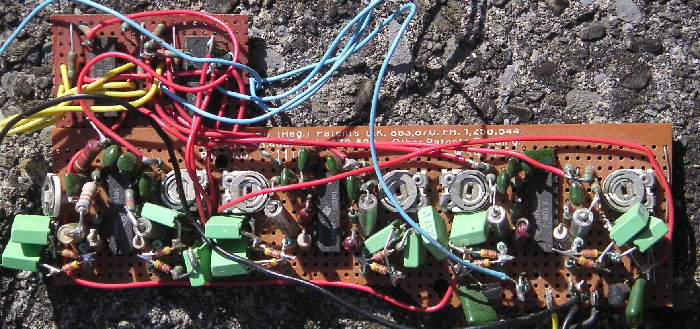
The problem was the total lack of bass, because the pickup has to be mounted close to the bridge, otherwise bending would push the string out of the magnetic range (as Roland builds them up to date). I tried a Bartolini hexaphonic pickup that came out then, with a softer directed magnet. It was possible to use it in the standard bridge position, but its crosstalk (probably around 30dB between strings) was clearly audible and brought back the dirt of the monophonic distortion.
Polyphonic Piezo Pickup
So I came to the conclusion, that only Piezo Pickups could solve this problem, because crosstalk up to 50dB was possible and the frequency range was full.
In '84, with help of ---- , who was building piezo pickups for acoustic instruments at that time, I discovered the mechanical problems and built the PARADIS pickups into solid body guitars. The sound was stunning clean, noise free and dynamic, yet unknown to the guitar player and did not fit the traditional guitar amps. We tried to convince the clients of the tremendous advantages but failed, being just young crazy. And really, the manufacturing of the pickup was very tricky. I spent a lot of time on each one and had to redo a lot of them because they failed later. Rolf managed to establish a serious manufacturing principle and patented it in '87.
The pickup worked perfectly well in acoustic guitars, too, with very little feedback, because it did not pick up from the guitar top, only from the strings. So we had the first perfect polyphonic piezo pickup (PPPP). Our only competitor, Shadow, did not get rid of the inequality of strings and some plasticness in the sound due to an acoustic short circuit between string and guitar top. Unfortunately we were not able to market this product. Partner Jury Rothen also inhibited, because he wanted the pickup exclusively for the guitars he built (less then one a month).
POLYDISTORTION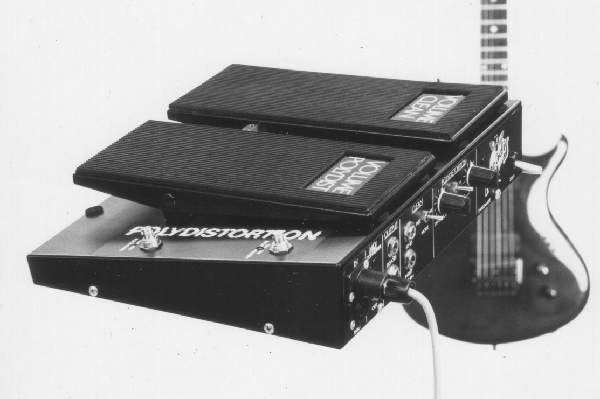
When the piezo pickup was ready, I immediately built a distortion for it (since that was the reason to start with the pickups!). It took a different filtering and never got the elastic sound of the magnetic pickups. The attack of the piezo is to hard. Actually its the true vibration of the string, and the magnetic pickups slow it down to become more natural, just like the top of an acoustic instrument.
Clients always started to solo on the guitar when they heard the distortion and criticized it for this problem before even realizing the great freedom they had for polyphonic playing. Also, we realized, that most rock musicians were not able to play two voice melodies and had their taste fixed to the simple chords and thus were not really interested in the advantage of the polyphonic distortion. Jazz and classic players that had the abilities and could have created great sounds with their harmonic understanding, did not even try POLYDISTORTION, because they "knew" that distortion was not for them. So the product was a flop, I made only about 15 of them. Thomas Diethelm recorded several LPs with it, on his Jury Rothen polyphonic classic guitar - an amazing sound!
listen to POLYDISTORTION (2MB of MP3) : Its not music, but more than just cords: I played a bit in some sound varieties and cut bits together so it did not exeed 2MB. There is no filitering, no compression, just POLYDISTORTION and some reverb.
I use two of those POLYDISTORTIONs up to date and people love it, think its sythesizer, while really, its much more expressive and immediate than a guitar synth could be.
It contains a dynamic clipping circuit that allows the reconstruction of some of the original dynamic. Its possible to play chords, distorted, organ like singing, and play a louder melody over it on one or several strings - to subtle to be presented at a music fair, which was the main publicity act of PARADIS:
If you want to build one, feel free. Its a very mature and simple schema.
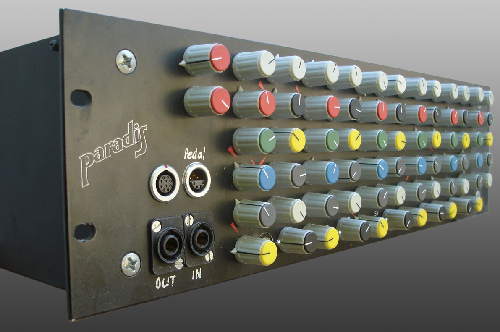
we also did a single big version with gain, parametric filter and dynamic control for each string. Mainly for Thomas Diethelm. But he did not have time to set all this in the studio and continued recording with the pedal model.
Other attempts to Polyphonic Guitar
Many guitar electronic pioneers built hexaphonic distortions for decades. Here is a little history.
Arround 1984 at PARADIS we hoped that the upcoming Guitar-to-MIDI converters would spread hexaphonic guitars on the marked where we could connect the POLYDISTORTION to. We tried to unify the manufacturers to create a standard for the polyphonic connector. But it failed. To many different technologies and some that did not work well made most guitar players wait or give up. Roland insists with the VG 8, without the success it deserves.
Another historical fact blocks this development: The rock guitar has a very strong tradition for dirt sounds. The listener does not expect a guitar to sound organ like. When the new visual of the electric guitar came up, the expected a new sound and it was created in the sixties with the equipment then available.
Also for this, PARADIS created a new style of designs to announce the new quality standard beyond acoustic and electric guitar. Many players understood, but most wanted nylon strings that are little suitable for distortion (it sounds interesting though!) because of their little sustain and ability to pitch bend.
The direct string sound
In the course of the development of the pickups and electronics and amplifications, I came to the conclusion, that we only can escape from the tradition of the chain magnetic pickup - treble eating cable - treble boosting amplifier - treble cutting 12' speaker by redesigning the whole system.
Peter Gregor gave me the kick to do it when he watched my measuring of traditional systems, he said: Why don't you just start from the sound the string really vibrates and amplify it in a way you can hear how it really is and then start to play with it until you like the sound. I did so, and it worked. Up to date, about half of my playing time is out of the piezo, directly into a linear studio amp.
For the electric guitar this philosophy means:
To get rid of the treble loss, it takes an amplifier in the guitar. To get rid of its noise (at leas at that time), it takes a phantom supply to the guitar. The amplifier does not need to boost treble as all traditional do, and the cabinet needs a tweeter to show the crystal clear sound of the piezo pickup (or even the magnetic, which becomes clear when fed into 1MOhm).
An ordinary distortion connected to this system would be too trebly. I had to boost middle as it was not common at the time (usually all filtering was after the distortion since it apparently is more effective!).
Only years later, Rocktron followed half way on this radical reconstruction of the guitar. Ljubo uses such a system, and probably a few more guitarists-inventors.
POLYSUBBASS
One more time, Peter Gregor gave me a strong hint, when we were listening to the fat sound of the traditional guitar. He reminded me, that the "lousy" 12" cabinets had strong distortions in the bass range and that the interference of the low strings produced low frequencies that can never be present in an instrument of that size. I immediately understood that I had to replace this effect in my linear system and built the first prototype of POLYSUBBASS in '85. From the start, it had 3 octavers for the lower three strings, a strong filter, that only lets the subharmonic pass and a dynamic regulation that fades this low frequency before it becomes insecure, due to the limited accuracy of the divider (as you can hear it on all the octave divider pedals except the Mutron that uses a very intelligent analog sustain circuit!)
Since the mixture of low frequencies ends up disturbing I also built the priority circuit that senses the lowest played string and switches off the upper ones in a very subtle way.
The whole "effect" is very discrete, you mainly feel the lack of the full low end if you switch it off. Some people use it very strongly though, to play the bass really. The first time I saw that was in Bern at the show of "Fourth World" an american band of brasilians (Flora Purim, Airtom Moreira), where José Neto only plays an AVALON and there is no Bass player. I had tears when I saw that the system really worked! José plays all kinds of style, including rock distortion - plus the bass on this one Instrument!



